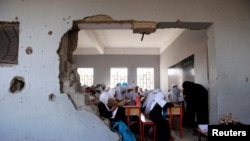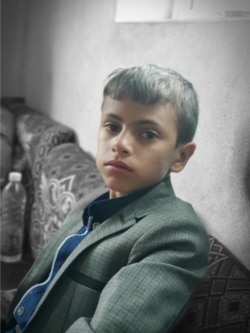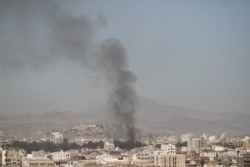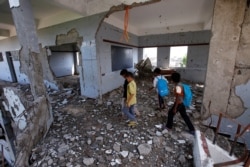Eight-year-old Mazen Mohia Aldeen likes science class, and he wanted to grow up to be an engineer.
But now he is considering dropping out of school. It has become too scary.
His fears began in 2017, when an airstrike hit a schoolhouse in his neighborhood. He was also in school and everyone screamed, Aldeen said. He later saw reports on social media of 13 dead and more than 80 injuries.
“Now I’m afraid and hate to go to school,” he said. “If it happens again, I won’t go back.”
In the past five years, at least 380 schools in Yemen have been attacked, caught in crossfire or occupied by militant groups, according to a new report by Yemeni and Britain-based rights groups.
The report, released last month by Mwatana for Human Rights and Ceasefire Center for Civilian Rights, blames the Saudi-led coalition for 153 airstrikes on or near schools. It says the Houthi military that controls Yemen’s north, as well as forces with Yemen’s internationally-recognized government in the south, are responsible for most of the other abuses.
Yemen has been at war for more than five years, with the southern government and Saudi Arabia fighting against the Houthis, who control the capital, Sanaa. The war is further complicated by other factions who hold key cities and the presence of extremist groups, like al-Qaida and Islamic State.
For years, the United Nations has called the situation in Yemen “the world’s worst humanitarian crisis,” and most children don’t have access to enough food, clean water or the opportunity to go to school.
And as some schools start to re-open their doors this week, teachers say the ongoing violence is robbing not just children, but the entire country of a future beyond the current suffering.
“People already don’t think that much about education anymore,” said Ahmed Muhammad Haimed, a History teacher at the school that was bombed in 2017, terrifying young Aldeen. “If they continue fighting, people will only be able to try to survive.”
War crimes
Haimed was in class when the airstrike hit. Two eight-year-old children he knew were killed.
“It was so loud I thought everyone in the school would surely die,” he said. “I was surprised that I survived.”
U.N. war crime investigators called Wednesday for a “criminal probe” in Yemen, saying all the warring parties have potentially committed war crimes amid a “pandemic of impunity.”
Investigators also blamed outside countries for selling weapons to the warring parties. The Saudi-led coalition’s leading suppliers are the United States, Britain, France and Canada. Iran is widely believed to supply weapons to the Houthis. The United Arab Emirates also is a key player, supporting militaries that are sometimes allied with the government, and sometimes at war.
The investigators said all sides have also been responsible for murders, kidnappings, sexual violence, torture and recruiting children into war.
“There is … no safe place for those near the front lines who face the risk of indiscriminate attacks,” Melissa Parke, the head of the U.N.’s Human Rights Council, said in a press release. “For children playing in fields in which landmines have been planted, for schoolchildren at risk of being recruited into armed forces or groups.”
Surviving terror
Hussein Muhammad Nasser, a 40-year-old father of three, was working in a shop when the airstrike hit Haimed’s school, shaking the entire neighborhood.
“My little daughter goes to that school,” he said. “But thank God she survived.”
Now, three years later, schools are still in harm’s way, but the danger by not sending his children to classes outweighs the danger of letting them go.
“It’s not safe,” he said. “But we can’t make them stop education.”
Yemen also faces widespread famine, the worst cholera outbreak in the world and is on track to becoming the world’s poorest country by next year.
If the crisis were to end today, it would take decades to recover, according to the U.N., and it is currently deepening as the coronavirus pandemic claims lives at a rate five times the global average.
Yemen has a relatively small number of confirmed COVID-19 cases, about 2,000, but the death rate is high because malnutrition and disease has weakened the population and the health care system is in ruins, according to Action Against Hunger, a U.S.-based aid group.
And for many Yemenis on the brink of survival, the loss of income amid lockdowns has been far more dangerous than the disease.
Despite all of this, and with schoolhouses reduced to rubble, for now, some children will still go to school, according to eight-year-old Aldeen.
“Some schools are destroyed,” he said, “But children still go because they want education.”
The contributor from Sanaa, Yemen, is not named for security reasons.













